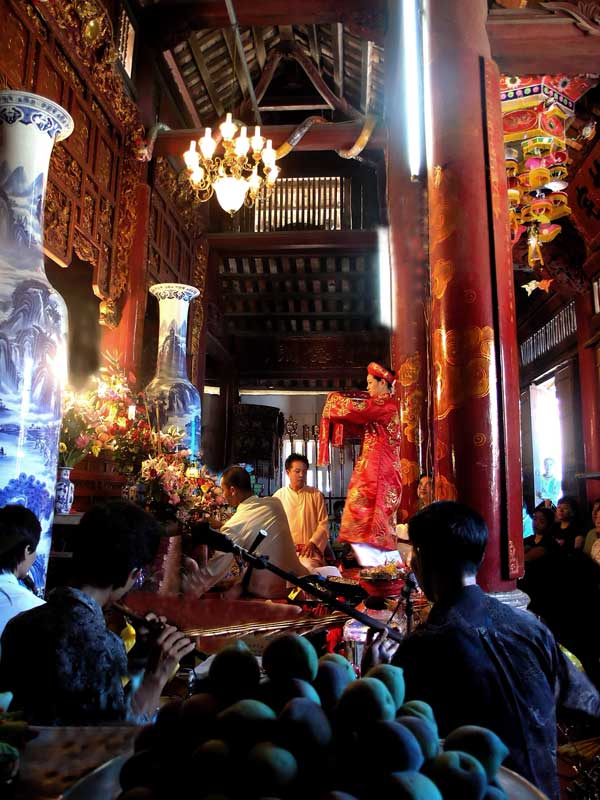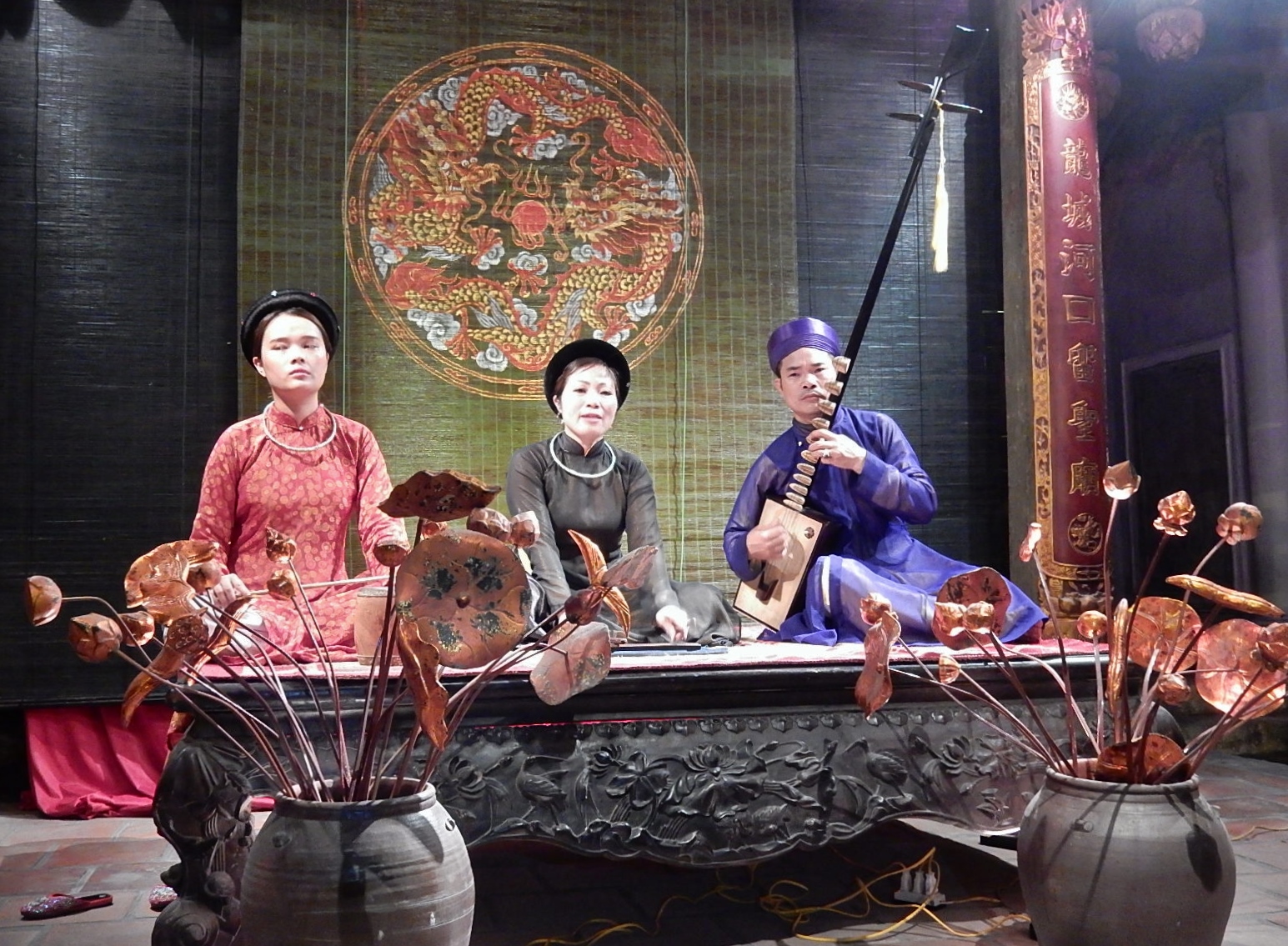|
Chầu Văn
Hát chầu văn (, Chữ Hán: 咭朝文), or in secular form hát văn (咭文),Dale Alan Olsen, ''Popular music of Vietnam: the politics of remembering'', 2008. p 278. index "chầu văn, ..." several entries. is a traditional folk art of northern Vietnam which combines trance singing and dancing. Its music and poetry are combined with a variety of instruments, rhythms, pauses, and tempos. Hát chầu văn originated in the 16th century and spread quickly. The main musical instrument used in hat van performance is the đàn nguyệt or moon-shaped lute. The genre is famous for its use in rituals for deity mediumship. Chầu văn serves two purposes: to help hypnotize the medium for reception of the deities and to accompany the medium's actions with appropriate music. The singing and dance in non-religious form is hát văn ("sung literature") without the word chầu ("to have an audiene with someone of higher power", "to perform a service and pay homage to a deity").Olga Dror ' ... [...More Info...] [...Related Items...] OR: [Wikipedia] [Google] [Baidu] |
Chữ Hán
Chữ Hán (𡨸漢, literally "Chinese characters", ), Chữ Nho (𡨸儒, literally "Confucian characters", ) or Hán tự (漢字, ), is the Vietnamese term for Chinese characters, used to write Văn ngôn (which is a form of Classical Chinese used in Vietnam during the feudal period) and Sino-Vietnamese vocabulary in Vietnamese language, was officially used in Vietnam after the Red River Delta region was incorporated into the Han dynasty and continued to be used until the early 20th century (111 BC – 1919 AD). Terminology * Stroke - nét * Stroke order - Bút thuận (筆順) * Radical - Bộ thủ (部首) * Regular script - Khải thư (楷書) * Simplified characters - chữ giản thể (𡨸簡體) * Traditional characters - chữ phồn thể (𡨸繁體) * Văn ngôn - Literary Chinese (文言) * Hán văn - synonym of Literary Chinese (漢文) * Kangxi radicals - Bộ thủ Khang Hi History In the late 3rd century BC, the newly established Qin dynasty made ... [...More Info...] [...Related Items...] OR: [Wikipedia] [Google] [Baidu] |
Folk Art
Folk art covers all forms of visual art made in the context of folk culture. Definitions vary, but generally the objects have practical utility of some kind, rather than being exclusively decorative art, decorative. The makers of folk art are typically trained within a popular tradition, rather than in the fine art tradition of the culture. There is often overlap, or contested ground with naive art, 'naive art'. "Folk art" is not used in regard to traditional societies where ethnographic art continue to be made. The types of objects covered by the term "folk art" vary. The art form is categorised as "divergent... of cultural production ... comprehended by its usage in Europe, where the term originated, and in the United States, where it developed for the most part along very different lines." For a European perspective, Edward Lucie-Smith described it as "Unsophisticated art, both fine and applied, which is supposedly rooted in the collective awareness of simple people. ... [...More Info...] [...Related Items...] OR: [Wikipedia] [Google] [Baidu] |
Musical Instrument
A musical instrument is a device created or adapted to make musical sounds. In principle, any object that produces sound can be considered a musical instrument—it is through purpose that the object becomes a musical instrument. A person who plays a musical instrument is known as an instrumentalist. The history of musical instruments dates to the beginnings of human culture. Early musical instruments may have been used for rituals, such as a horn to signal success on the hunt, or a drum in a religious ceremony. Cultures eventually developed composition and performance of melodies for entertainment. Musical instruments evolved in step with changing applications and technologies. The date and origin of the first device considered a musical instrument is disputed. The oldest object that some scholars refer to as a musical instrument, a simple flute, dates back as far as 50,000 - 60,000 years. Some consensus dates early flutes to about 40,000 years ago. However, most historians be ... [...More Info...] [...Related Items...] OR: [Wikipedia] [Google] [Baidu] |
Dan Nguyet
Dan or DAN may refer to: People * Dan (name), including a list of people with the name ** Dan (king), several kings of Denmark * Dan people, an ethnic group located in West Africa **Dan language, a Mande language spoken primarily in Côte d'Ivoire and Liberia * Dan (son of Jacob), one of the 12 sons of Jacob/Israel in the Bible **Tribe of Dan, one of the 12 tribes of Israel descended from Dan * Crown Prince Dan, prince of Yan in ancient China Places * Dan (ancient city), the biblical location also called Dan, and identified with Tel Dan * Dan, Israel, a kibbutz * Dan, subdistrict of Kap Choeng District, Thailand * Dan, West Virginia, an unincorporated community in the United States * Dan River (other) * Danzhou, formerly Dan County, China * Gush Dan, the metropolitan area of Tel Aviv in Israel Organizations *Dan-Air, a defunct airline in the United Kingdom *Dan Bus Company, a public transport company in Israel *Dan Hotels, a hotel chain in Israel *Dan the Tire Man, a ... [...More Info...] [...Related Items...] OR: [Wikipedia] [Google] [Baidu] |
Lên đồng
Lên đồng (, votive dance, "to mount the medium", or "going into trance") is a ritual practiced in Vietnamese folk religion, in which followers become spirit mediums for various kinds of spirits. There is a common confusion between "lên đồng" and "hầu bóng" (which is the most prominent ritual of Đạo Mẫu). During a ceremony of "Hầu Bóng" (lit. Serving the (Holy) Reflections), a priest or priestess would mimic the deities by dressing and acting like them. The priest is in full control of their body. A successful ceremony is one in which the priest feels the deities' essences but it does not mean the deities' spirits enter the priest's mortal body. As a religious leader authorized to perform the sacred rituals of a religion, especially as a mediatory agent between humans and one or more deities, the "thanh đồng" in Đạo Mẫu is more of the equivalent of a priest rather than a medium or a shaman. Overview Lên đồng is commonly associated with the reli ... [...More Info...] [...Related Items...] OR: [Wikipedia] [Google] [Baidu] |
16th-century Music Genres
The 16th century begins with the Julian year 1501 ( MDI) and ends with either the Julian or the Gregorian year 1600 ( MDC) (depending on the reckoning used; the Gregorian calendar introduced a lapse of 10 days in October 1582). The 16th century is regarded by historians as the century which saw the rise of Western civilization and the Islamic gunpowder empires. The Renaissance in Italy and Europe saw the emergence of important artists, authors and scientists, and led to the foundation of important subjects which include accounting and political science. Copernicus proposed the heliocentric universe, which was met with strong resistance, and Tycho Brahe refuted the theory of celestial spheres through observational measurement of the 1572 appearance of a Milky Way supernova. These events directly challenged the long-held notion of an immutable universe supported by Ptolemy and Aristotle, and led to major revolutions in astronomy and science. Galileo Galilei became a champion o ... [...More Info...] [...Related Items...] OR: [Wikipedia] [Google] [Baidu] |
Vietnamese Traditional Theatre
Vietnamese may refer to: * Something of, from, or related to Vietnam, a country in Southeast Asia ** A citizen of Vietnam. See Demographics of Vietnam. * Vietnamese people, or Kinh people, a Southeast Asian ethnic group native to Vietnam ** Overseas Vietnamese, Vietnamese people living outside Vietnam within a diaspora * Vietnamese language * Vietnamese alphabet * Vietnamese cuisine * Vietnamese culture See also * List of Vietnamese people A ''list'' is any set of items in a row. List or lists may also refer to: People * List (surname) Organizations * List College, an undergraduate division of the Jewish Theological Seminary of America * SC Germania List, German rugby union ... * {{disambiguation Language and nationality disambiguation pages ... [...More Info...] [...Related Items...] OR: [Wikipedia] [Google] [Baidu] |
Vietnamese Folk Religion
Vietnamese folk religion ( vi, tín ngưỡng dân gian Việt Nam, sometimes just called , Chữ Hán: ) is the ethnic religion of the Vietnamese people. About 86% of the population in Vietnam are associated with this religion. Vietnamese folk religion is not an organized religious system, but a set of local worship traditions devoted to the , a term which can be translated as "spirits", "gods" or with the more exhaustive locution "generative powers". These gods can be nature deities or national, community or kinship tutelary deities or ancestral gods and the ancestral gods of a specific family. Ancestral gods are often deified heroic persons. Vietnamese mythology preserves narratives telling of the actions of many of the cosmic gods and cultural heroes. The Vietnamese indigenous religion is sometimes identified as Confucianism since it carries values that were emphasized by Confucius. is a distinct form of Vietnamese shamanism, giving prominence to some mother goddesses i ... [...More Info...] [...Related Items...] OR: [Wikipedia] [Google] [Baidu] |
Vietnamese Music
Traditional Vietnamese music encompasses a large umbrella of Vietnamese music from antiquity to present times, and can also encompass multiple groups, such as those from Vietnam's ethnic minority tribes. History Traditional Vietnamese music has been mainly used for religious activities, in daily life, and in traditional festivals. Vietnam's ethnic diversity has also made its music scene diverse. Each of Vietnam's ethnic group owns many unique types of musical instruments. The influence of Chinese culture on Vietnamese music is also quite prevalent, such as maids, harps and erhu. However, traditional Vietnamese music, whilst often compared to traditional Chinese music, is not exactly the same. Royal court music Royal Vietnamese court music first appeared in the 1040s after a successful seaborne raid against Champa led by king Lý Thái Tông in 1044. Cham women were taken as singers, dancers and entertainers for the court. The chronicles recorded that a special palace for Cham wo ... [...More Info...] [...Related Items...] OR: [Wikipedia] [Google] [Baidu] |

.jpg)




